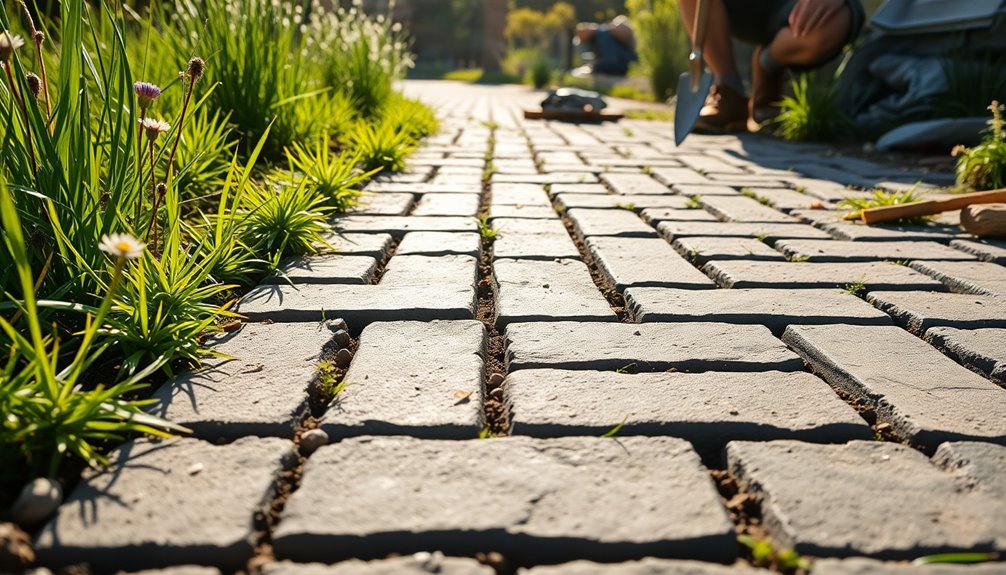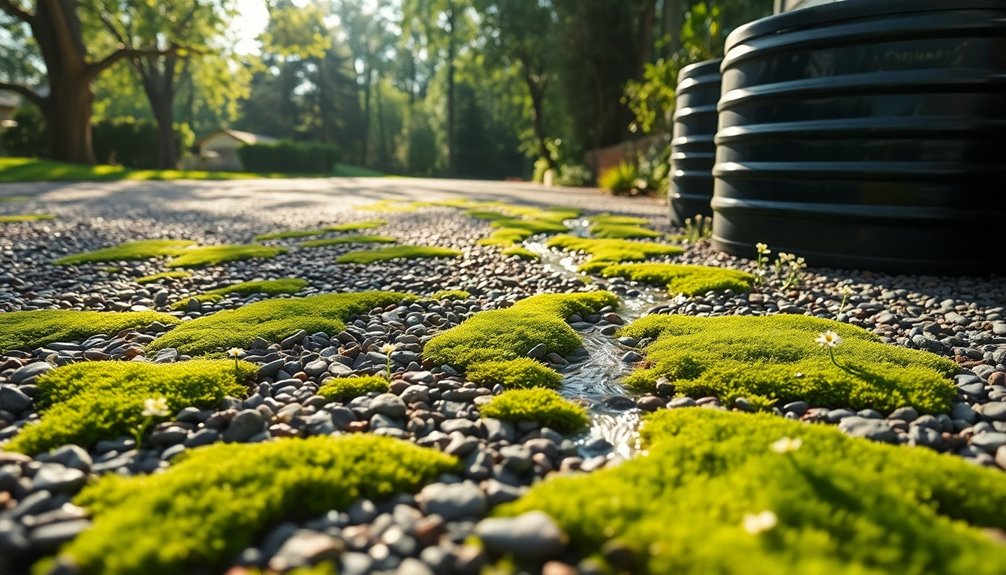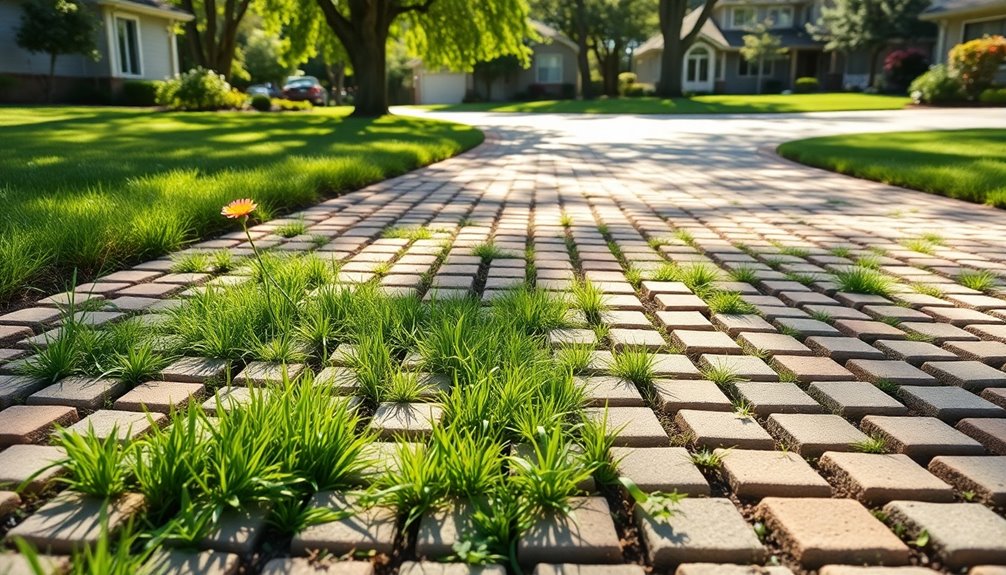If you're looking for budget-friendly ideas for pervious driveways, consider materials like gravel, crushed concrete, or plastic paving grids, which are cost-effective and eco-friendly. You can install them yourself by following simple steps and using budgeting tools to keep track of costs. Regular maintenance, like removing debris and compacting the surface, will boost longevity. Plus, enhancing your driveway with native plants can improve curb appeal. Discover more tips on creating a sustainable driveway!
Understanding Permeable Driveways
When you consider upgrading your driveway, understanding permeable driveways is important. These innovative surfaces allow water to seep through, reducing stormwater runoff and promoting groundwater recharge. This feature is essential for environmental sustainability. Additionally, choosing sustainable delivery practices can further enhance your overall eco-friendly efforts.
You can choose from various materials, like gravel driveways or permeable pavers, each offering unique aesthetic and functional benefits. Unlike traditional impermeable surfaces, permeable driveways filter pollutants from rainwater, enhancing groundwater quality and easing the load on drainage systems. Additionally, installing a permeable driveway can contribute to sustainable practices that minimize environmental impact. Furthermore, opting for ethical brands that prioritize eco-friendly materials in construction can also support broader sustainability goals.
Regular maintenance is key to guarantee effective water infiltration and prevent blockages. By opting for permeable driveways, you not only contribute to eco-friendliness but also potentially increase your property value and reduce long-term stormwater management costs. Embrace this smart choice for your next driveway upgrade!
Cost-Effective Materials for Pervious Driveways
Choosing cost-effective materials for your pervious driveway can make a significant difference in both your budget and the environment.
Gravel driveways are one of the most affordable options, costing around $1 to $3 per square foot. If you want a sustainable choice, consider using crushed concrete, which typically runs between $3 to $5 per square foot. Additionally, accurate categorization of your project expenses can help ensure you stay within your budget. Utilizing expense tracking apps can further enhance your ability to monitor costs effectively throughout the project.
While permeable pavers are pricier at $5 to $10 per square foot, they offer long-term savings through reduced maintenance. For a durable, easy-to-install solution, plastic paving grids are a great choice, costing about $2 to $4 per square foot. Additionally, expense tracking tools can help you manage the costs associated with your driveway project effectively.
DIY Installation Tips for Budget-Friendly Driveways

When you're ready to tackle your DIY pervious driveway, start by selecting the right materials that fit both your budget and aesthetic. Tracking expenses for this project will help you allocate funds effectively and avoid overspending. Follow a clear step-by-step installation guide to guarantee proper drainage and durability. Additionally, using budgeting apps can further streamline your financial management for the project. With the right preparation and techniques, you can create an effective and stylish driveway without breaking the bank. Additionally, consider implementing zero-based budgeting to effectively allocate your funds towards this project and ensure you stay within your budget.
Materials Selection Strategies
Selecting the right materials for your driveway can make a significant difference in both cost and appearance.
For a budget-friendly driveway project, consider using crushed concrete, a recycled option that's often cheaper than traditional paving.
Permeable pavers are another great choice; they're stylish, provide excellent drainage, and can often be found at a discount from construction suppliers.
If you prefer a simpler approach, gravel driveways with stone edging deliver a professional look while being easy to install.
Tar and chip driveways offer a rustic charm with eco-friendly materials, while hardpack materials give you a stable surface with minimal maintenance.
Explore these driveway options to find the best materials used for your budget needs!
Step-by-Step Installation Guide
Installing a budget-friendly pervious driveway can be a rewarding DIY project that enhances your property's functionality and aesthetics.
Start by preparing your site: clear debris and grade the area for proper drainage, essential for a permeable driveway.
Next, lay down high-quality geotextile fabric to separate the soil from the gravel, preventing soil mixing.
Expand and anchor geocell panels over the fabric, creating a honeycomb structure that supports the gravel and distributes vehicle weight evenly.
Fill the geocell with suitable driveway material, balancing permeability and stability, and compact it for a level surface.
Finally, secure edging around the driveway to keep the gravel in place and prevent erosion, boosting both durability and visual appeal.
Maintenance Strategies for Longevity
To guarantee your pervious driveway remains functional and attractive, regular maintenance is essential. Implementing effective maintenance strategies can greatly enhance the longevity of your permeable driveways.
Start by regularly inspecting the surface, removing debris, leaves, and sediment to guarantee proper water infiltration and prevent clogging. For gravel driveways, consider applying a fresh layer of gravel periodically to maintain permeability. Additionally, ensuring timely payments for maintenance services can help keep your driveway in top condition. Consistent maintenance reminders can serve as a reminder to avoid late fees associated with service delays.
Compacting the surface minimizes shifting and rut formation, especially for gravel and porous concrete. Utilizing geotextile fabric beneath the surface material helps prevent soil mixing, reducing repair needs.
Don't forget seasonal maintenance, like reseeding grass paver areas or filling voids in permeable pavers, to bolster resilience against weather-related wear and tear. Additionally, employing advanced receipt scanning technology can help you keep track of maintenance expenses effectively. Your driveway will thank you for it!
Environmental Benefits of Permeable Driveways

Maintaining your pervious driveway not only guarantees its longevity but also opens up a host of environmental benefits.
Permeable driveways allow rainwater to seep into the ground, greatly reducing stormwater runoff and the risk of urban flooding. This process enhances groundwater recharge, contributing to better water quality and availability in local aquifers. Additionally, AI-driven tools can help homeowners discover the best permeable materials suited for their specific needs. Implementing advanced trend analysis can further assist homeowners in selecting the most effective solutions for their driveways.
As water filters through the permeable surface, it helps maintain healthier ecosystems by trapping pollutants, reducing water pollution.
Additionally, these driveways can mitigate the urban heat island effect, leading to cooler surface temperatures in your neighborhood. By integrating permeable driveways, you're also promoting local biodiversity, supporting vegetation growth, and creating habitats for wildlife. Furthermore, adopting sustainable consumption patterns allows homeowners to align their practices with broader environmental goals.
It's a smart choice for both your property and the environment.
Enhancing Aesthetics With Landscaping Elements
While enhancing the aesthetics of your permeable driveway, you can transform it into a stunning focal point of your property.
Incorporating native plants and shrubs along the edges boosts curb appeal and supports local biodiversity with minimal maintenance. Decorative gravel or stone borders create a visually appealing connection while containing loose materials.
Consider installing permeable pavers integrated with grass or moss for a natural look that still accommodates vehicles.
Strategically placing rain gardens or bioretention areas not only manages stormwater runoff but also adds an eco-friendly feature to your landscape.
Finally, using recycled materials like crushed concrete or reclaimed wood for edging enhances your driveway's visual appeal while promoting sustainable design options.
Conclusion
So, while you could spend a fortune on traditional driveways that just push rainwater away, why not embrace the irony of saving money and benefiting the environment with a pervious driveway? You'll not only keep your wallet happy, but you'll also create a beautiful, eco-friendly space. Who knew that being budget-conscious could lead to such a stylish, sustainable solution? Sometimes, the best choices are the ones that save you cash while saving the planet, too.



